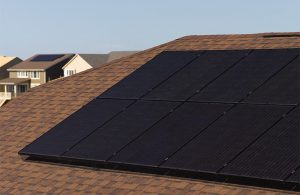Vertical rooftop PV specialist switches on two more systems on green roofs in Norway – pv magazine International
Norwegian vertical solar system specialist, Over Easy Solar, recently supplied a 102 kW bifacial commercial rooftop system, just a few months after supplying a 45 kWp system for a school rooftop. Both systems were installed on so-called green rooftops by the Norwegian project company, Solenergi Fusen.
Norway-based PV system provider Over Easy has deployed two vertical solar arrays on green rooftops in Norway.
The company deployed a 102 kW installation covering 1200 m2 on a flat-roofed commercial building in Oslo. It also supplied a 45 kW system for a school rooftop project earlier in the year. Both flat roofs are planted with vegetation, so-called green roofs.
The installations were installed by Solenergi Fusen, an 11-year-old Norwegian project company specializing in commercial rooftop and building-integrated PV. The projects follow an earlier 5 kW pilot project, also located in Oslo.
Over Easy has a novel, low-height, all-in-one system design for flat rooftops. Its systems are delivered to the installation site in a pre-assembled single unit that includes its unconventional heterojunction bifacial modules, the mounting rack, and the cabling.
“The 102 kW installation was mechanically installed in less than two days with a team of four workers,” Over Easy CEO, Trygve Mongstad, told pv magazine.
The company calls its prefabricated product a “vertical photovoltaic (VPV) unit” and each one has an output of 200 W. They come in two sizes, one for green roofs, with a size of 1,600 mm x 1,500 mm x 345 mm and a weight of 26, and one for roofs without vegetation, measuring 1,600 mm x 1,500 mm x 265 mm and weighing 25 kg. The clearance for both products is 120 mm and 40 mm, respectively.
“We can fit 6 kW or a bit more on each pallet, and the product comes completely ready with the mounting system, a true plug-and-play system for flat and green rooftop solar installations,” said Mongstad.
As for ballast, the low-height design and weight of 11 kg/m2 means the need for ballast units is reduced and, in some cases, it is not necessary, according to Mongstad, which he said also contributes to ease of installation and a lighter weight for the system.
The system’s glass-glass modules are made with 3.2 mm solar glass and claim up to 95% bifaciality with an operating temperature range of -40 C to 85 C.
The company’s first green roof pilot was installed at an Oslo school. According to Mongstad, the pilot PV system integrated well with the rooftop vegetation and the energy yields were 20-30% higher than conventional east-west flat rooftop installations in the same area.
“We ticked in at above 1000 kWh/kW for the first year of operation, which is pretty good for our latitude,” said Mongstad.
Recently, pv magazine reported that Dutch scientists used thermal models to understand why vertical solar installations were delivering higher yields, attributing the performance boost to the systems’ consistently lower operating temperatures.
“We’ve also observed the same effect,” commented Mongstad who noted that his company’s collaboration with researchers from Institute for Energy Technology in Norway found that the heat exchange of the vertical panels was “indeed much higher than what is expected for tilted solar panels”, but he also attributes higher yields to the “increased irradiation that high-bifaciality vertical solar panels” receive.
This content is protected by copyright and may not be reused. If you want to cooperate with us and would like to reuse some of our content, please contact: editors@pv-magazine.com.





